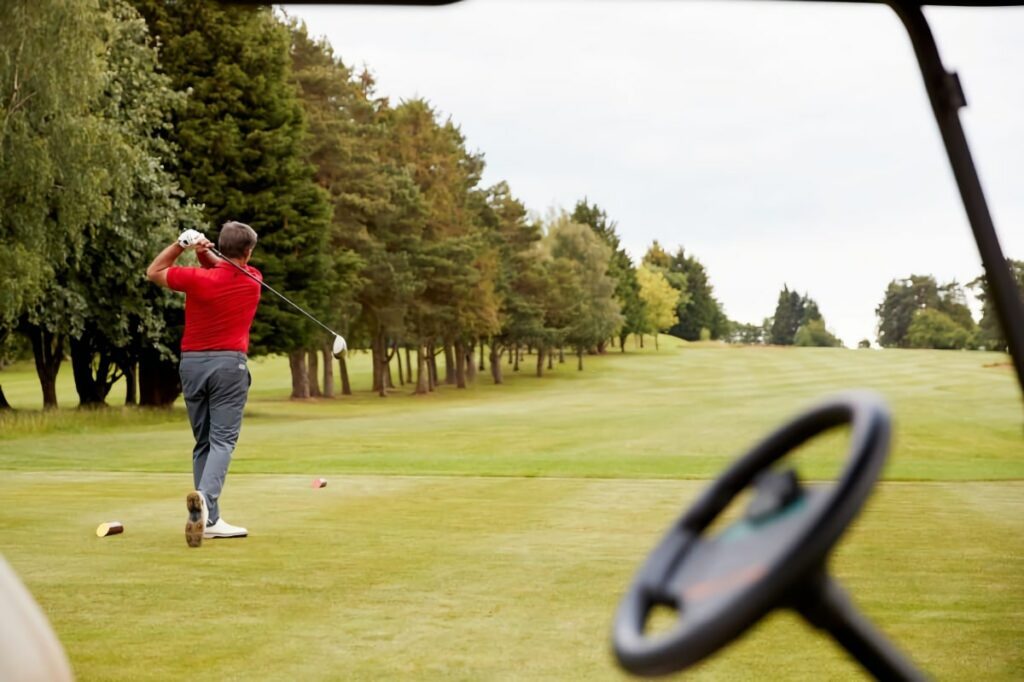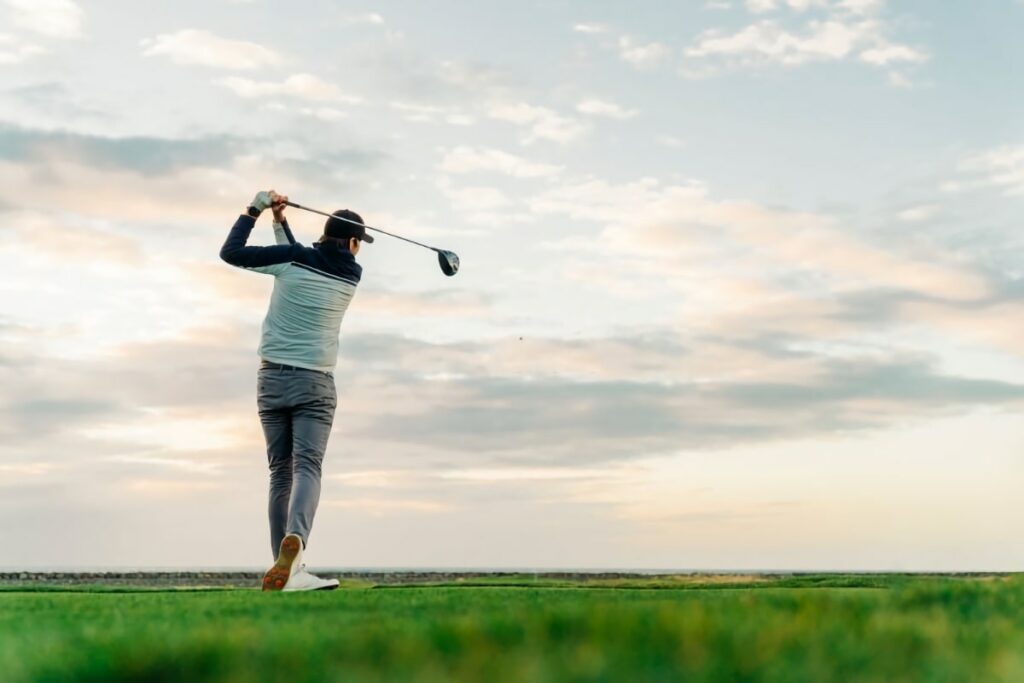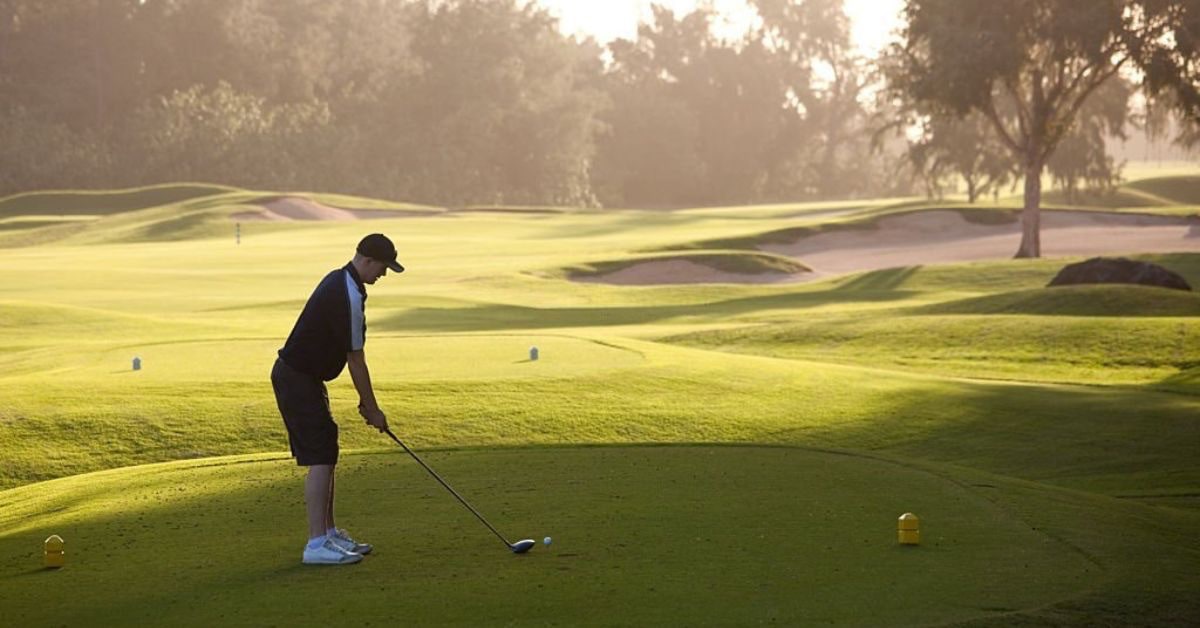When golfers struggle off the tee, their first instinct is to pull out another club.
Naturally, many will reach for their 3 wood when the driver is misbehaving since it offers plenty of distance with a more manageable shaft length.
But, why is it so common that golfers can hit their 3 wood but not their driver?
In this post, I’ll guide you through the differences between the 3 wood swing and the driver swing. Then, I’ll teach you how to hit the driver with more accuracy.
If you want to optimize your scoring potential, you need all clubs in play.
So without any hesitation, let’s get into it!
Why Can I Hit 3 Wood But Not Driver?
Typically, drivers are two inches longer than 3 woods. In addition, drivers have approximately 3 to 7 degrees less loft on the clubface. The combination of these factors makes it hard to hit the driver straight and achieve optimal ball flight.
First, we’ll compare the 3 wood swing and the driver swing. Read on!

The 3 Wood Swing vs The Driver Swing
Often, golfers mistakenly think there’s a different swing for every club in the bag.
The good news is the 3 wood swing and the driver swing are similar. Instead, it’s the club itself that will create a few changes in launch angle and ball flight.
Let’s take a look at how they stack up against each other.
Shaft Length
The first difference between the 3 wood and the driver is shaft length.
On average, the 3 wood is about two inches shorter than the driver. Since the 3 wood shaft is shorter, you’ll find yourself standing closer to the ball.
When standing closer and using a shorter club, you will feel more in control of the shot you are trying to hit. This generally makes the 3 wood easier to swing.
For this reason, some golfers prefer to use a 3 wood shaft in their driver. That way, they can have the benefits of a driver head, while standing closer to the ball.
Ball Position & Angle of Attack
The next key difference is the ball position and angle of attack with each club.
With the 3 wood, you naturally want to strike the ball with a sweeping motion. So, the ball should be positioned a ball or two forward of center.
Conversely, the driver is designed to be teed up and hit on the up. Therefore, the ball position should be much further forward — inside the front heel.

Spin Rate
Drivers have lower spin rates to help get you more distance.
The problem, of course, is that when spin rates are too low for you, the ball won’t get up in the air, and it’s much harder to control.
With the extra loft, 3 woods have more backspin. Generally, this makes it easier to launch a 3 wood, especially when the ball is teed up slightly to improve strike.
Clubhead Speed
The wider the swing arc, the faster the clubhead speed at the point of impact.
Since the driver is longer than the 3 wood, you can generate more club head speed with the driver than you can the 3 wood.
More clubhead speed will increase carry distance. But, with faster speed, accuracy can become compromised as it’s harder to deliver a square face.

How to Hit Driver With More Accuracy
I love my driver and have complete confidence in it — most of the time!
However, when it starts to go off, and I notice a few shots heading left or right, here are the steps I follow in order to hit a driver with more precision:
- Equipment: Use the right driver for your skill level and swing type.
- Setup: Ball position inside your front heel, feet shoulder-width apart.
- Swing: Focus on generating width, and use your lower body.
- Impact: Keep your head behind the ball, and transfer your weight.
- Follow-through: Accelerate through the ball, and maintain balance.
Let’s cover each step in some detail.
Step 1: Equipment
Before swinging the driver, you need to make sure you’re using the right one!
If you’ve been struggling with accuracy, add a little loft to the club head. This will help you launch the ball closer to how you would with a higher-lofted 3 wood.
Fortunately, most drivers are adjustable. That way, you can alter the loft angle to offer you some extra launch and spin to get the ball in the air sooner.
There are also draw bias drivers on the market that can help improve a slice. Or alternatively, use a fade bias driver if you tend to hook your tee shots.
Step 2: Setup
Next, focus on how you set up behind the ball at address.
When setting up to hit the driver, you want to position the ball inside the line of your front heel. That way, you can strike the ball on the up, with an ascending angle of attack for optimal launch conditions and distance.
Also, make sure your trail shoulder is slightly lower than your lead shoulder. Having a lower trail shoulder helps promote this upward angle of attack.
Keep your feet just slightly wider than shoulder-width apart. Don’t let your feet get too wide, as it can make the turn and weight transfer become more difficult.
Step 3: Swing
Now, it’s time to swing the club.
When I swing the driver, I think about width. The wider I can keep the club, and the more extension I can create, the easier it is to square the clubface up at impact.
Try to delay the wrist hinge a little to ensure you create a wider swing arc.
In addition, use your core and legs in the swing. When you primarily use hands and arms to try and generate power, it becomes difficult to repeat the motion.
Step 4: Impact
As the clubface returns to the ball on the downswing, it’s time for the strike.
Since you want to hit up on the driver, keep your head behind the ball at impact.
Your weight should have mostly transferred to the lead side at impact. With your head staying behind the ball, it makes it easier to square up the clubface.
Step 5: Follow-Through
Finally, you want to think about how you follow through after impact.
Keep your weight transferring forward through the ball. Eventually, you want to end up looking at the target with all of your weight set on your front foot.
The follow-through is important as it demonstrates to us whether there was proper acceleration and weight transfer through the downswing and impact.
PRO TIP: It’s helpful to work on balance and stability in your legs if you tend to struggle with a balanced follow-through position.
Check out the video below by MeAndMyGolf, which outlines and demonstrates three extra tips to hit accurate drives off the tee:
Final Thoughts
In summary, golfers tend to hit their 3 wood better than their driver because of the shorter shaft length. This allows you to stand closer to the ball, increasing the level of control over the clubface at the point of impact.
Generally, a good golf swing is about delivering the clubface square to the target with speed. If you’re struggling to hit the driver, focus on these steps:
- Equipment: Use the right driver for your skill level and swing type.
- Setup: Ball position inside your front heel, feet shoulder-width apart.
- Swing: Focus on generating width, and use your lower body.
- Impact: Keep your head behind the ball, and transfer your weight.
- Follow through: Accelerate through the ball, and maintain balance.
By putting in the necessary work to optimize your driver swing and iron out any flaws, you’ll start to build the confidence you need to hit it long and straight.
Back yourself, and start splitting fairways!


